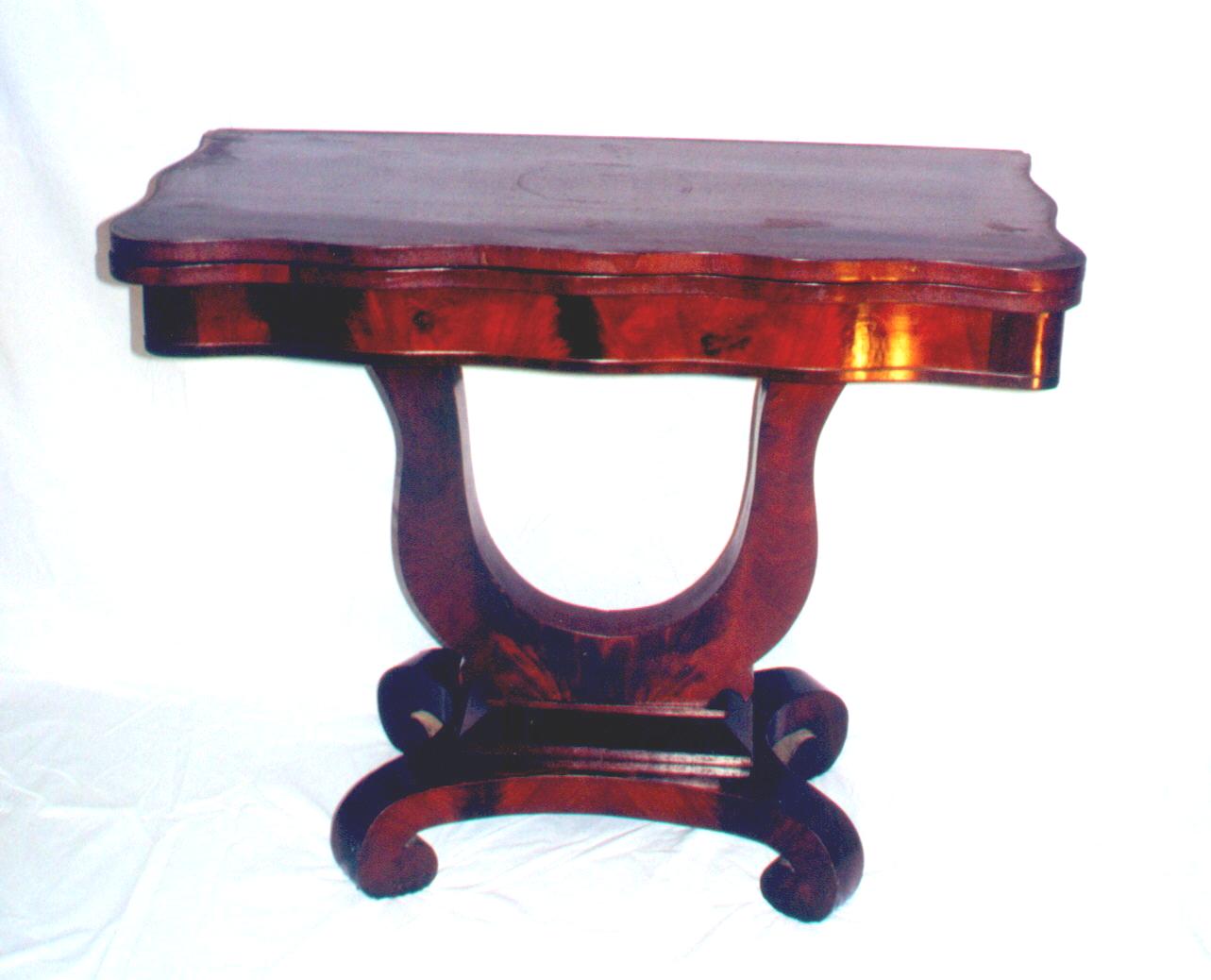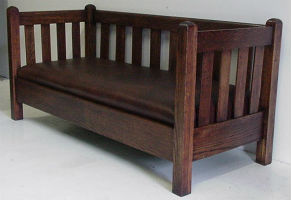
CRYSTAL RIVER, Fla. – In classical music one of the most important notations in the score is the symbol for “rest.” It denotes the pause that refreshes, the golden silence. It tells the musician to take a break, catch a breath, skip a beat, just stop. It may be for just one beat or it may be for a few measures or for an entire passage. The composer uses the rest for many reasons, but primarily to emphasize a point or provide a space for a seamless transition of direction or tempo.
The rest is such an important element that the score to one the most monumental works of Western classical music, Beethoven’s Symphony No. 5, actually begins with a rest. Beethoven used the space to smooth out the pace of the two-quarter time to fit the staccato rhythm of the first four notes.
What does that have to do with furniture? Sometimes a rest may be called for in furniture design or direction not so much to emphasize a point, but to provide the space for a change in direction. It tells the designers to move on to something other than the same old tired thing they have been doing for a generation or more. It says, “Enough is enough. Let’s do something different.”
But a simple change in technique is not the rest the design needs. It doesn’t mean a shift from overblown Rococo Revival to another overblown form such as Renaissance Revival. It doesn’t mean moving from Queen Anne to Chippendale or from Federal to Empire. It’s more basic than that. It calls for a change in outlook and attitude.
It is tempting to think that the introduction of the Windsor chair to American furniture early in the 18th century was just such a rest. It provided a utilitarian form in an unpretentious package that was something new, definitely a change in direction. But that was not a change in design attitude, it was a change in construction technique.
The first serious change in direction in mainstream American furniture design, a mini-revolution of a sort, occurred just before the middle of the 19th century in the form commonly but erroneously called Empire in today’s topsy-turvy market. But I am not talking about the elegant Empire of Duncan Phyfe or Charles Honoré Lannuier, the lavishly decorated, often stenciled and carved pier tables and delicate chairs. I refer to the form shown in the broadside advertisement of the Meeks brothers in 1833, the first advertisement to show a complete furniture design. The new design was based on the French Restauration style of the time. It even used the French spelling. Today it is referred to as “Late Classicism,” the last of the classical periods in American furniture.
The appeal of the style was that it followed the established trend of heavier, more visually imposing furniture popular at the time, but it left off entirely the surface decorations of the Empire motif. The new furniture had no inlays, no ormolu or brass mounts, no carving, no caryatids and no animal parts. The allure lay in the smooth sweeping curves of the case goods, the unadorned beautiful simplicity of the expanses of mostly mahogany veneer and the almost complete absence of exposed metal hardware. Elaborate surface decoration in American furniture had come to a “rest,” temporarily at least.
While this was going on in the major design centers, another design system had been quietly at work for decades. The Shakers came to America in 1774, creating isolated settlements in New England, New York, Kentucky and Ohio. There they produced their own style of furniture based on simplicity, devoid of all ornamentation. At first glance the furniture appears to be unique but further study reveals that some of it shows the influence of neoclassical work, adapted to the Shaker way of life and work. The Shakers continued their furniture endeavors into the 20th century and beyond. Another refreshing rest period in the long line of decorated furniture.
While the Meeks brothers were making their Late Classicism furniture in their Broad Street factory and distributing it all over the country, including the South through a New Orleans outlet, the next phase of seriously decorative furniture was leaking out of New York in the form of Rococo Revival.

By mid-century the “French Antique” style was firmly in control and decorative excess was held in check only by cost. The more you were willing to spend the more decorative and over-carved the pieces you could buy. The less expensive pieces were mostly made by machine. The big money bought individual craftsmanship and unique carving patterns. The flowing frivolity of Rococo Revival was eventually usurped by the more mechanical Renaissance Revival, another French inspiration promoted by the new Emperor of France, Napoleon III.
But Renaissance Revival again only changed the technique, moving from hand carving to the application, in layers, of mostly machine-made ornaments to frames resembling architectural designs.
But another move was afoot to simplify it all once again. This time the impetus came from England, not France, in the written works of Henry Cole and Owen Jones, English promoters and designers who roundly criticized the extravagance of the designs exhibited in 1851 at the London Crystal Palace. John Ruskin was formulating the tenets of his reform movement at the same time and he heavily influenced another young London designer named Charles Locke Eastlake.
Eastlake, like the Meeks brothers and the Shakers, felt the beauty of the furniture was seen in the simple functional design and the unadorned clarity of the natural wood grain. His name and ideas were quickly subverted by the American factory production system, which produced fairly simple case goods bedecked with overdone machine cut ornamentation. Eastlake eventually publicly disassociated his name with American factory-made furniture but the seed for a rest had been planted again.
It took John Larkin’s brother-in-law, Elbert Hubbard, a disciple of Ruskin, to found the next movement in America in the Roycroft communities in New York, producing handmade unadorned furniture and fixtures in accordance with Ruskin’s views.
But it took an American furniture maker working in his own factory setup to spread the idea of the Arts and Crafts movement to the American public. Gustav Stickley brought the production of Renaissance Revival, Rococo Revival and Aesthetic Movement furniture to a grinding halt with the introduction of his Craftsman furniture. America was taken with the simple unadorned lines and obvious high quality construction methods of his work, which was immediately imitated by many manufacturers, including most of his brothers. His flat oak surfaces and exposed joinery was refreshing to a public at long last tired of Victoriana. It was just time for another rest.
Arts and Crafts/Mission was essentially done by the end of World War I and the second phase of the Colonial Revival was in full swing, leading to the historical stylistic excesses of the Depression era. Simplicity was over.
But there was one more rest period in the works from an unlikely source. Young designers in Europe were restless again and met in Paris in 1925 to shake things up a bit. They did and the result was Art Moderne, what today we call Art Deco. While most Art Moderne partially fit the description of the rest stop, much of it didn’t, showing extreme variations as outlandish as Rococo or Renaissance. But one subcategory of the style seems to have taken lessons from Meeks and Eastlake. That was the so-called “waterfall” furniture of the 1930s and 1940s.

It derived its character and beauty from the simple idea of running veneer from the back to the front of the top of a chest instead of side to side and having the veneer pattern flow over a smoothly rounded front edge, like going over a waterfall. The effect was so striking that little other surface decoration was employed.
That seems to be the last significant rest in American furniture design.
__
By FRED TAYLOR
Send comments, questions and pictures to Fred Taylor at P.O. Box 215, Crystal River, FL 34423 or email them to him at info@furnituredetective.com. Visit Fred’s newly redesigned website at www.furnituredetective.com and check out the new downloadable “Common Sense Antiques” columns in .pdf format.
His book “How To Be a Furniture Detective” is available for $18.95 plus $3 shipping. Send check or money order for $21.95 to Fred Taylor, P.O. Box 215, Crystal River, FL 34423.
Fred and Gail Taylor’s DVD, “Identification of Older & Antique Furniture” ($17 + $3 S&H) is also available at the same address. For more information call 800-387-6377 (9 a.m.-4 p.m. Eastern, M-F only), fax 352-563-2916, or info@furnituredetective.com. All items are also available directly from his website.



